A Proportionality of Body Calculator is a health and aesthetics-oriented tool to assess the harmony and balance of an individual’s body dimensions. It helps determine whether various body measurements — such as height, waist, hips, shoulders, chest, arms, and legs — are proportionate. While beauty and physical appearance are subjective, proportionality is often associated with symmetry, balance, and overall physical wellness. This calculator is especially popular in the fitness, bodybuilding, tailoring, and fashion industries and among individuals looking to evaluate or enhance their physique.
What Is Body Proportionality?
Body proportionality refers to how well different body parts relate in size and ratio. A proportionate body does not necessarily mean thin or muscular, but one in which key body parts are balanced and symmetrical. This concept is used in health and fitness, visual arts, and ergonomics, where the ideal human form is studied for function and aesthetics.
Proportionality often includes comparisons such as:
- Waist-to-hip ratio
- Shoulder-to-waist ratio
- Leg-to-torso length
- Arm-to-height ratio
- Chest-to-waist ratio
The proportionality of these measurements can be used to assess body symmetry, aesthetic appeal, and sometimes even posture and musculoskeletal balance.
Purpose of the Proportionality of Body Calculator
The Proportionality of Body Calculator is used to:
- Evaluate the balance of body dimensions
- Identify areas of muscular or structural imbalance
- Support aesthetic goals in bodybuilding or fitness
- Assist in custom clothing design or tailoring
- Provide reference points for physical improvement plans
- Offer insight into postural or orthopedic asymmetries
This calculator allows users to visualize and understand how their body structure compares to traditional proportions or personal fitness goals.
Key Inputs Required
To generate accurate results, the calculator typically requires several body measurements, including:
- Height
- Weight (optional for composition reference)
- Waist circumference
- Hip circumference
- Shoulder width
- Chest or bust measurement
- Thigh and calf circumference
- Arm and forearm circumference
- Inseam or leg length
- Torso length
Some calculators may allow for gender, age, and fitness level to personalize results further or provide comparison ranges.
How the Calculator Works
The calculator compares user-entered measurements against standardized ratios representing average or ideal proportionality models. These ratios are often derived from anatomical studies, aesthetic theories (such as the “golden ratio”), or performance-oriented criteria in sports science.
Once the data is entered, the calculator:
- Computes ratio comparisons between various body parts
- Evaluate symmetry and proportionality
- Identifies deviations from standard or ideal proportions
- Provides visual or numeric results, often with suggestions or observations
Some versions may even provide feedback for training plans, such as targeting specific muscle groups or improving posture.
Benefits of Using a Proportionality Calculator
- Personalized Analysis: Understand your unique body structure beyond general size or weight.
- Fitness Guidance: Helps shape training programs focused on symmetry and balance.
- Improved Aesthetics: Guides those seeking a more sculpted or harmonious physique.
- Health Indicators: Identifies potential postural or muscular imbalances.
- Useful for Professionals: Valuable for personal trainers, physical therapists, and fashion designers.
Ideal Users of the Calculator
The Proportionality of Body Calculator is suitable for:
- Fitness enthusiasts and bodybuilders
- Personal trainers and coaches
- Fashion designers and tailors
- Physiotherapists and orthopedic specialists
- People aiming to improve their physical balance and aesthetics
- Artists and animators studying human anatomy and form
This tool is also helpful for people recovering from injury or correcting postural issues.
Applications in Different Fields
a) Fitness and Bodybuilding
Used to assess muscle development and ensure symmetry in training routines.
b) Fashion and Tailoring
Essential for designing clothing that fits well and enhances body lines.
c) Healthcare and Rehabilitation
Helpful in detecting skeletal or muscular imbalances that may require correction.
d) Visual Arts and Design
Helps artists draw or model realistic human figures with correct proportions.
Limitations and Considerations
While highly informative, the calculator also has some limitations:
- Does Not Measure Health Directly: It focuses on proportion, not internal wellness or medical status.
- Aesthetic Standards Vary: What is considered “ideal” may differ across cultures, genders, and eras.
- Dependent on Accurate Measurement: Results may be skewed by inconsistent or incorrect inputs.
- May Not Reflect Functional Fitness: Some people with great strength or health may fall outside standard proportions.
- Should Be Used for Guidance, Not Judgment: Proportionality is just one aspect of physical assessment.
Best Practices for Use
- Take measurements carefully, ideally with a flexible measuring tape and assistance if needed.
- Record data consistently, at the same time of day, and under similar conditions.
- Use results to inform, not criticize — focus on goals, not unrealistic ideals.
- Track changes over time to see improvements in symmetry or balance.
- Consult professionals for support if results suggest significant imbalance or health concerns.
Future Enhancements and Digital Integration
Modern technology is expanding how we use body proportionality data:
- 3D body scanners and apps that create full-body profiles for detailed analysis
- Fitness platforms that generate workouts based on proportionality scores
- AI-assisted tailoring tools that recommend clothing cuts based on proportions
- Virtual fitness coaches that identify muscular imbalances visually
- Integrated wellness dashboards that combine proportionality with other health data
These innovations make proportionality tracking more accessible and personalized than ever before.
Conclusion
The Proportionality of Body Calculator is a versatile and insightful tool that helps individuals evaluate the balance and symmetry of their bodies. It provides valuable data beyond essential size and weight, whether for health, aesthetics, performance, or design. Understanding your body’s unique proportions allows you to set more targeted fitness goals, choose better-fitting clothing, or even improve posture and function. This calculator can become a powerful resource for self-awareness, improvement, and holistic body management when used thoughtfully and consistently.


